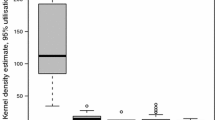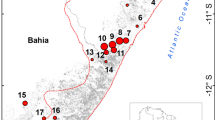Abstract
Orangutans (Pongo pygmaeus) in a Sumatran swamp forest used home ranges far larger than any described so far for the species, in spite of living at the highest density on record. Although it was difficult to estimate home range sizes, minimum reliably estimated home range sizes for adult females are ca. 850 ha, whereas subadult and adult males used ranges of at least ca. 2500 ha, and perhaps much more. Range overlap was very high: up to 16 adult females, 9 adult males and at least 15 subadult males were seen within a single 4-ha square in the center of the study area. We found no evidence for the use of seasonally distincthome ranges—commuters—, and only some subadult males may have been transients—wanderers—without a stable home range. The large size of the home ranges is attributed to the coarse grain of the habitat mosaic, with orangutans converging on parts with a high density of favored fruit trees. Orangutans at this swamp forest included a variety of habitat types within their ranges.
Similar content being viewed by others
REFERENCES
Altmann, S. A. (1974). Baboons, space, time, and energy. Am. Zool. 14: 221-248.
Ashton, P. S., Givnish, T. J., and Appanah, S. (1988). Staggered flowering in the dipterocarpacae: New insights into floral production and the evolution of mast fruiting in the aseasonal tropics. Am. Nat. 132: 44-66.
Bearder, S. K., and Martin, R. D. (1980). The social organisation of a nocturnal primate revealed by radio tracking. In Amlaner, C. J., and Macdonald, D.W. (eds.), A Handbook on Biotelemetry and Radio Tracking, Pergamon Press, Oxford, pp. 633-648.
Burt, W. H. (1943). Territoriality and home range concepts as applied to mammals. J. Mamm. 24: 346-352.
Chapman, C. A., and Wrangham, R.W. (1993). Range use of the forest chimpanzees of Kibale: Implications for the understanding of chimpanzee social organisation. Am. J. Primatol. 31: 263-273.
Chapman, C. A., Wrangham, R. W., and Chapman, L. J. (1994). Indices of habitat-wide fruit abundance in tropical forests. Biotropica 26: 160-171.
Delgado, R., and van Schaik, C. P. (2000). The behavioral ecology and conservation of the orangutan (Pongo pygmaeus): A tale of two islands. Evol. Anthro. 9:201-218.
Djojosudharmo, S., and van Schaik, C. P. (1992).Why are orang utans so rare in the highlands? Altitudinal changes in a Sumatran forest. Tropical Biodiv. 1: 11-22.
Dunbar, R. I. M. (1988). Primate Social Systems, Croom Helm, London.
Galdikas, B. M. F. (1978). Orang-Utan Adaptation at Tanjung Puting Reserve, Central Borneo, Doctoral thesis, University of California, Los Angeles.
Galdikas, B. M. F. (1979). Orangutan adaptation at Tanjung Puting Reserve: Mating and ecology. In Hamburg, D. A., and McCown, E. R. (eds.), The Great Apes, Benjamin/Cummings, California, pp. 194-233.
Galdikas, B. M. F. (1988). Orangutan diet, range, and activity atTanjung Puting, Central Borneo. Intern. J. Primatol. 9: 1-35.
Galdikas, B. M. F., and Wood, J. (1990). Great ape and human birth intervals. Am. J. Phys. Anthro. 83: 185-192.
Hasegawa, T. (1990). Sex differences in ranging patterns. In Nishida, T. (ed.), The Chimpanzees of the Mahale Mountains: Sexual and Life History Strategies, University of Tokyo Press, Tokyo, pp. 99-114.
Horr, D. A. (1975). The Borneo orang-utan: Population structure and dynamics in relation to ecology and reproductive strategy. Primate Behavior 4: 307-323.
Horr, D. A. (1977). Orang-utan maturation: Growing up in a female world. In Chevalier-Skolnikoff, S., and Poirier, F. E. (eds), Primate Bio-social Development: Biological, Social, and Ecological Determinants, Garland Publishing, Inc., New York, pp. 289-321.
Isbell, L. A., Cheney, D. L., and Seyfarth, R. M. (1990). Costs and benefits of home range shifts among vervet monkeys (Cercopithecus aethiops) in Amboseli National Park, Kenya. Behav. Evol. Sociobiol. 27: 351-358.
Jolly, A. (1972). The Evolution of Primate Behaviour, Macmillan, New York.
Jolly, A., and Pride, E. (1999). Troop histories and range inertia of Lemur catta at Berenty, Madagascar: A 33-year perspective. Intern. J. Primatol. 20: 359-374.
Kenward, R. (1987). Wildlife Radio Tagging: Equipment, Field Techniques and Data Analysis, Academic Press, London.
Knott, C. D. (1998). Changes in orangutan caloric intake, energy balance, and ketones in response to fluctuating fruit availability. Intern. J. Primatol. 19: 1061-1079.
Leighton, M. (1993). Modeling dietary selectivity by Bornean orangutans: Evidence for integration of multiple criteria in fruit selection. Intern. J. Primatol. 14: 257-313.
Leighton, M., and Leighton, D. R. (1983). Verterbrate responses to fruiting seasonality within a Bornean rain forest. In Sutton, S. L., Whitmore, T. C., and Chadwick, A. C. (eds.), Tropical Rainforest; Ecology and Conservation, Clarendon Press, Oxford, pp. 181-196.
Macdonald, D. W., Ball, F. G., and Hough, N. G. (1980). The evaluation of home range size and configuration using radio tracking data. In Amlaner, C. J., and Macdonald, D. W. (eds.),Ahandbook on Biotelemetry and Radio Tracking, Pergamon Press, Oxford, pp. 405-423.
MacKinnon, J. R. (1974). The behaviour and ecology of wild orang-utans (Pongo pygmaeus). Anim. Behav. 22: 3-74.
MacKinnon, J. R. (1989). Field studies of wild orang-utans: Current state of knowledge. In Seth, P. K., and Seth, S. (eds.), Perspectives in Primate Biology, Vol. 3, Today & Tomorrow's Printers and Publishers, New Delhi, India, pp. 173-186.
Mitani, J. C. (1985). Mating behaviour of male orangutans in the Kutai Game Reserve, Indonesia. Anim. Behav. 33: 391-402.
Mitani, J. C. (1989). Orangutan activity budgets: Monthly variations and the effects of body size, parturition, and sociality. Am. J. Primatol. 18: 87-100.
Rijksen, H.D. (1978). A Field Study on Sumatran Orang-Utans (Pongo pygmaeus abelii Lesson, 1827): Ecology, Behaviour and Conservation, H. Veenman & Zonen, Wageningen.
Rijksen, H.D., and Meijaard, E. (1999). Our Vanishing Relative: The Status ofWild Orang-Utans at the close of the Twentieth Century, Kluwer Academic Publishers, Dordrecht.
Rodman, P. S. (1984). Foraging and social systems of orangutans and chimpanzees. In Rodman, P. S., and Cant, J. G. H. (eds.), Adaptations for Foraging in Nonhuman Primates: Contributions to an Organismal Biology of Prosimians, Monkeys and Apes, Columbia University Press, New York, pp. 134-160.
Rodman, P. S. (1988). Diversity and consistency in ecology and behaviour. In Schwartz, J. H. (ed.), Orang-Utan Biology, Oxford University Press, New York, pp. 31-51.
Singleton, I. (2000). Ranging behaviour and seasonal movements of Sumatran orangutans (Pongo pygmaeus abelii) in swamp forests, PhD Thesis, University of Kent at Canterbury, UK.
Steenbeek, R., Korstjens, A. H., and van Schaik, C. P. (1999). Tenure related changes in wild Thomas's langurs. III: Range use. In Female Choice and Male Coercion in Wild Thomas's Langurs, Ph.D. Thesis, University of Utrecht, Utrecht, Netherlands, pp. 117-136.
Suzuki, A. (1992). The population of orangutans and other non-human primates and the forest conditions after the 1982-83's fires and droughts in Kutai National Park, East Kalimantan, Indonesia. In Ismail, G., Mohamed, M., and Omar, S. (eds.), Forest Biology and Conservation in Borneo, Yayasan Sabah, Kota Kinabalu, pp. 190-205.
te Boekhorst, I. J. A., Schurmann, C. L., and Sugardjito, J. (1990). Residential status and seasonal movements of wild orang-utans in the Gunung Leuser reserve (Sumatera, Indonesia). Anim. Behav. 39: 1098-1109.
Trevor-Deutsch, B., and Hackett, D.F. (1980). Anevaluation of several grid trapping methods by comparison with radio telemetry in a home range study of the Eastern chipmunk (Tamias striatus L.). In Amlaner, C. J., and Macdonald, D.W. (eds.), A Handbook on Biotelemetry and Radio Tracking, Pergamon, Oxford, pp. 375-386.
Trivers, R. L. (1972). Parental investment and sexual selection. In Sexual selection and the descent of man. Campbell, B. (ed.) Aldine, Chicago, pp. 136-179.
Utami, S., Mitrasetia, T., and van Hooff, J. A. R. A. M. (2000). Factors influencing fluctuations in orang-utan density and male mating strategy. In Bimaturism in Orang-Utan Males: Reproductive and Ecological Strategies, Ph.D.Thesis, University of Utrecht, Utrecht, Netherlands, pp. 107-119.
van Schaik, C. P. (1986). Phenological changes in a Sumatran rain forest. J. Trop. Ecol. 2: 327-347.
van Schaik, C. P. (1999). The socioecology of fission-fusion sociality in orangutans. Primates 40: 73-90.
van Schaik, C. P., Azwar, and Priatna, D. (1995). Population estimates and habitat preferences of orangutans based on line transects of nests. In Nadler,R.D., Galdikas, B. F. M., Sheeran, L. K., and Rosen, N. (eds.), The Neglected Ape, Plenum Press, New York, pp. 129-147.
van Schaik, C. P., and van Hooff, J. A. R. A. M. (1996). Toward an understanding of the orangutan's social system. In McGrew, W. C., Marchant, L. F., and Nishida, T. (eds.), Great Ape Societies, Cambridge University Press, Cambridge, pp. 3-15.
Voigt, D. R., and Tinline, R. R. (1980). Strategies for analyzing radio tracking data. In Amlaner, C. J., and Macdonald, D. W. (eds.), A Handbook on Biotelemetry and Radio Tracking, Pergamon Press, Oxford, pp. 387-404.
Wich, S. A., and C. P. van Schaik. (2000). The impact of El Niño on mast fruiting in Sumatra and elsewhere in Malesia. J. Trop. Ecol. 16: 563-577.
Whitmore, T. C. (1984). Tropical Rain Forests of the Far East, Clarendon Press, Oxford.
Author information
Authors and Affiliations
Corresponding author
Rights and permissions
About this article
Cite this article
Singleton, I., van Schaik, C.P. Orangutan Home Range Size and Its Determinants in a Sumatran Swamp Forest. International Journal of Primatology 22, 877–911 (2001). https://doi.org/10.1023/A:1012033919441
Issue Date:
DOI: https://doi.org/10.1023/A:1012033919441




